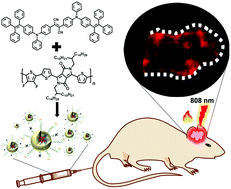Identifying glioblastoma margins using dual-targeted organic nanoparticles for efficient in vivo fluorescence image-guided photothermal therapy†
Abstract
Current therapeutics for glioblastoma multiforme (GBM) treatment are unsatisfactory due to their limited ability to control the progression from tumour margins. In this work, organic nanoparticles (NPs) are synthesized by co-encapsulating a fluorogen with aggregation-induced emission to generate a bright red emission for imaging and a semiconducting polymer to offer NIR absorption for photothermal therapy. The NPs are further modified with different ratios of two targeting ligands, folate and cRGD peptide. The best ratio that performs specific and efficient GBM targeting is screened out through in vitro and ex vivo fluorescence imaging analysis. The NPs with an FA to cRGD ratio of 25 : 75 exhibit superior ability to target GBM cells in vitro and also show efficient accumulation at the GBM margin and in the tumour interior after in vivo administration. The progression of GBM can be greatly suppressed through photothermal therapy, which provides a simple but promising strategy for GBM treatment.

- This article is part of the themed collections: 2021 Materials Horizons Advisory Board collection, 20th Anniversary of Aggregation-Induced Emission and Horizons Community Board Themed Collection – Nanobiomedicine


 Please wait while we load your content...
Please wait while we load your content...